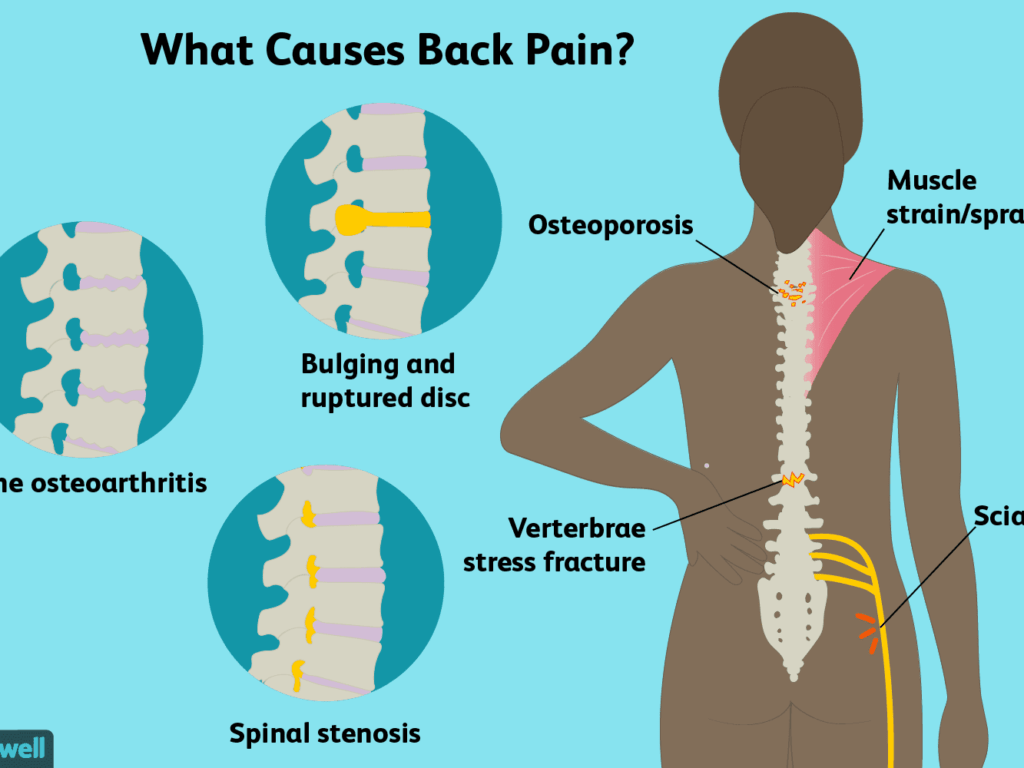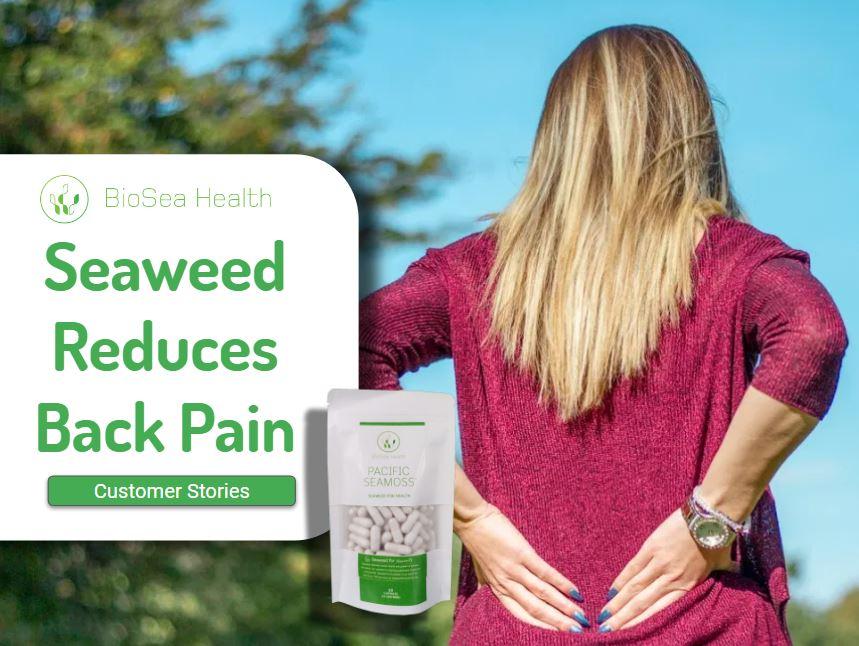Seaweed reduces back pain was not something we were told about when we introduced Pacific Seamoss in 2019. But then we had many customers of Pacific Seamoss come back and tell us they had reduction of back pain. They had other benefits, but reduction in pain was widely reported and in particular natural arthritis relief.
Inflammation in joints occurs for many reasons, the two most common being overuse and arthritis. Both conditions interfere with normal function and stop us from leading a healthy active life. With Pacific Seamoss our customers are reporting pain and inflammation is reduced in arthritic or injured joints. They say they are active again, and greatly appreciate the better quality of life. Even our more athletic customers tell us their niggling training injuries have disappeared.
Reasons for less back pain
A seminal Nature publication by Professors Brown and Xiao in 2019 [11] said that the rats in a functional food study was related to the reduction in inflammation rather than obesity that the experiment studied. Along with the large reduction in inflammation in liver and gut, changes in microbiome, the animals fed functional food had additional cartilage. There are many reasons that Pacific Seamoss reduce back pain.
- Pacific Seamoss contains plant sterols and other macronutrients that interfere with the chronic inflammation process.
- It is a pre-biotic – up-regulating your healthy gut bacteria that pump inflammation-reducing short-chain fatty acids into the bloodstream.
- It has a high daily level of nutrients and trace elements such as potassium, Zinc, Selenium and Calcium
- With high levels of Vitamins including A, B1, B2, and B6
- Good levels of Sulphur
In addition in animal studies, it was more effective than aspirin as an analgesic. [9]
There are clinical trials with seaweed from the brown seaweeds and extracts of fucoidans, and show reduction in arthritis with extracts of kelp [10] but Pacific Seamoss is whole food, is available, has vitamins and minerals and consumers report outstanding results.
Seaweed reduces back pain testimonials
For some testimonials for back pain check out testimonials on this site here. Here are just 4 simple ones. It seems it takes 4 to 6 weeks before people notice, and it will be because the body gets used to pain. It takes a while to realise that pain is not there.
- Chris – a 65 year old ex parquet flooring business owner could not stand up without hanging onto a support and with pain. After 3 months of seaweed he realised when he stood up, the creak and crack were still there, but the pain had gone.
- Wayne, a printer realised when he stood up, knees bent, with a box of paper the pain had reduced. Took 4 weeks
- Gray realised after a month that he woke up without knee pain. After 2 months he could do a fun run with his kids – something he had been unable to do for 10 years.
- Lindsay had a back pain for over 15 years. Realised after 3 weeks that he had no more pain.
These customers were consuming about 4 grams of seaweed per day. Some have reduced down to 2.5 g and finding that pain relief continues. Stopping for a couple of weeks means the pain returns.
What Causes Back Pain

Natural Medicines
The Arthritis Foundation says that there are 10 vitamins and supplements, backed by science, that help relieve arthritis pain. You can read more on natural medicine for joint pain here.
Knee and Back Pain Prevalence
It is just not back pain. Knee pain is the second most common chronic pain condition in the U.S. behind back pain. Over one-third of all Americans will have a knee pain issue at some point in their lives. Between 15% and 20 % of men will encounter knee pain, and almost 20% of women will have knee pain.
References
[1] Makkar, F & Chakraborty, K 2017, Antidiabetic and anti-inflammatory potential of sulphated polygalactans from red seaweeds Kappaphycus alvarezii and Gracilaria opuntia, International Journal of Food Properties, vol. 20, no. 6, pp. 1326-37.
[2] Kumar, S.A., Brown, L. Seaweeds as potential therapeutic interventions for the metabolic syndrome. Rev Endocr Metab Disord 14, 299–308 (2013). https://doi.org/10.1007/s11154-013-9254-8
[3] John O, Mouatt P, Prasadam I , Xiao Y, Panchal S, Brown L 2019 The edible native Australian fruit, Davidson’s plum (Davidsonia pruriens), reduces symptoms in rats with diet-induced metabolic syndrome, Journal of Functional Foods, (56) Pages 204-215, ISSN 1756-4646,
https://doi.org/10.1016/j.jff.2019.03.018.
[4] Kumar M & Sharma S (2020) Toxicological effects of marine seaweeds: a cautious insight for human consumption, Critical Reviews in Food Science and Nutrition, DOI: 10.1080/10408398.2020.1738334
[5] D’Orazio, N.; Gemello, E.; Gammone, M.A.; De Girolamo, M.; Ficoneri, C.; Riccioni, G. Fucoxantin: A Treasure from the Sea. Mar. Drugs 2012, 10, 604-616.
[6] Tirtawijaya, G., Haque, M. N., Choi, J. S., Moon, I. S., Meinita, M. D. N., Choi, J.-S., & Hong, Y.-K. (2019). Spinogenesis and Synaptogenesis Effects of the Red Seaweed Kappaphycus alvarezii and Its Isolated Cholesterol on Hippocampal Neuron Cultures. Preventive Nutrition and Food Science, 24(4), 418. (PubMed)
[7] Wanyonyi, S., Du Preez, R., Brown, L., Paul, N. A., & Panchal, S. K. (2017). Kappaphycus alvarezii as a food supplement prevents diet-induced metabolic syndrome in rats. Nutrients, 9(11), 1261.(Pubmed)
[8] du Preez, R.; Paul, N.; Mouatt, P.; Majzoub, M.E.; Thomas, T.; Panchal, S.K.; Brown, L. Carrageenans from the Red Seaweed Sarconema filiforme Attenuate Symptoms of Diet-Induced Metabolic Syndrome in Rats. Mar. Drugs 2020, 18, 97.
[9] Zakaria, A, Jais, MR & Ishak, R 2018, Analgesic properties of Nigella sativa and Eucheuma cottonii extracts Journal of natural science, biology, and medicine, vol. 9, no. 1, p. 23.
[10] Myers SP, O’Connor J, Fitton JH, et al. A combined phase I and II open label study on the effects of a seaweed extract nutrient complex on osteoarthritis. Biologics. 2010;4:33-44. Published 2010 Mar 24. doi:10.2147/btt.s8354
[11] Sekar, S., Shafie, S., Prasadam, I. et al. Saturated fatty acids induce development of both metabolic syndrome and osteoarthritis in rats. Sci Rep 7, 46457 (2017). https://doi.org/10.1038/srep46457

